Global Small Satellite Market By Component, By Satellite Type, By Orbit, By Application, By End User, By Region & Segmental Insights Trends and Forecast, 2024 – 2034
- Industry: Aerospace & Defense
- Report ID: TNR-110-1239
- Number of Pages: 420
- Table/Charts : Yes
- August, 2024
- Base Year : 2024
- No. of Companies : 10+
- No. of Countries : 29
- Views : 10091
- Covid Impact Covered: Yes
- War Impact Covered: Yes
- Formats : PDF, Excel, PPT
The global small satellite market is experiencing robust growth, driven by increasing demand for satellite-based services such as Earth observation, telecommunications, and scientific research. The proliferation of satellite constellations for global connectivity, coupled with advancements in miniaturization and cost-effective launch solutions, is fueling market expansion. Key trends include the rise of CubeSats and nanosatellites, which offer flexibility and lower costs, making them attractive for both commercial and government applications.
Opportunities abound in emerging markets and the development of advanced power systems and propulsion technologies. Additionally, collaborations between private companies and space agencies are expected to further drive innovation and market penetration, positioning small satellites as critical components in the evolving space industry landscape. In terms of revenue, the global small satellite market was worth US$ 12.8 Bn in 2023, anticipated to witness a CAGR of 16.2% during 2024 – 2034.
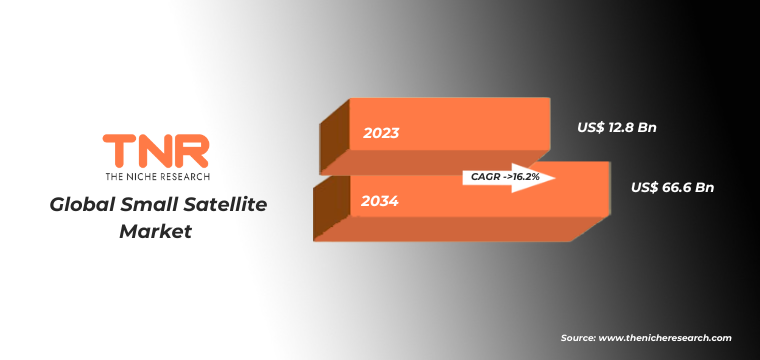
Global Small Satellite Market Segmental Analysis:
Small Satellite Market By Component
The power system segment has rapidly emerged as the fastest-growing segment in the global small satellite market, driven by advancements in energy efficiency and the increasing demands of satellite missions. Modern power systems are crucial for enhancing satellite performance, enabling longer mission durations, and supporting more sophisticated payloads. Innovations in solar panels, batteries, and power management technologies have made these systems more reliable and capable of supporting the growing complexity of small satellite operations. As satellite missions become more ambitious, the demand for robust, efficient power systems is expected to continue rising, solidifying their critical role in the market.

Small Satellite Market By Satellite Type
In 2023, the mini-satellite segment dominated the global small satellite market, capturing a substantial revenue share of 36.4%. This leadership position reflects the segment’s versatility and growing adoption across various industries, including telecommunications, Earth observation, and scientific research. Mini-satellites, typically weighing between 100 and 500 kg, offer a balance between capability and cost-efficiency, making them attractive for both commercial and governmental applications. Their ability to carry more advanced payloads compared to smaller satellites has fueled their popularity, solidifying their strong presence in the market.
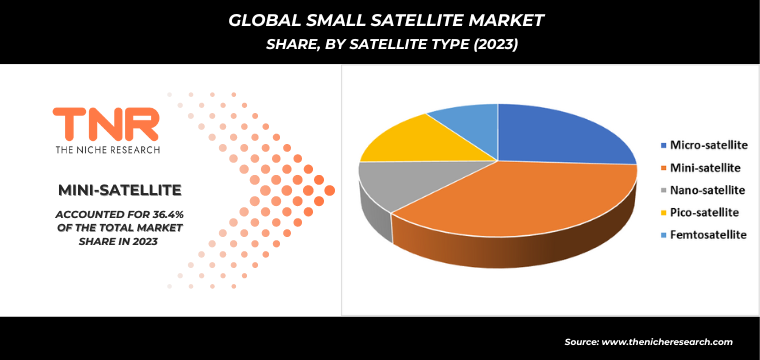
Small Satellite Market By Orbit
The low earth orbit (LEO) segment emerged as the dominant force in the global small satellite market in 2023, capturing a significant revenue share of 48.7%. LEO’s popularity is driven by its cost-effectiveness, lower latency, and suitability for a wide range of applications, including communications, Earth observation, and scientific research. The orbit’s accessibility and the growing demand for satellite constellations, particularly for global internet coverage, have solidified LEO’s position as the preferred choice for small satellite deployments worldwide.
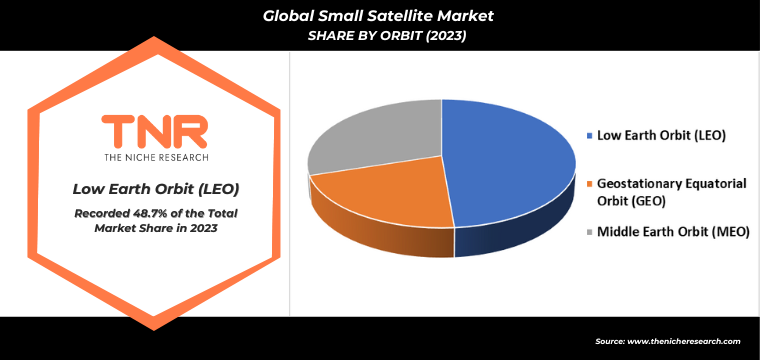
Small Satellite Market By Application
In 2023, the Earth observation and remote sensing segment secured the highest share in the global small satellite market, reflecting its critical role across various industries. The demand for real-time data and high-resolution imagery for applications such as environmental monitoring, agriculture, disaster management, and urban planning has fueled the growth of this segment. Small satellites’ ability to provide frequent, detailed observations at a lower cost compared to traditional satellites has made them indispensable tools for both commercial and governmental entities, driving this segment to the forefront of the market.
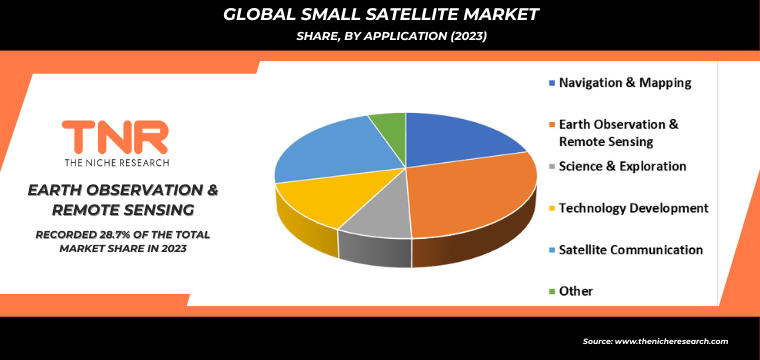
Small Satellite Market By End User
In 2023, the commercial segment led the global small satellite market, achieving a robust CAGR of 10.8%. This growth is driven by the increasing adoption of small satellites by private companies for applications such as telecommunications, Earth observation, and satellite-based services. The commercial sector’s investment in satellite constellations for global connectivity and data services has significantly contributed to this segment’s expansion. As businesses increasingly rely on small satellites to enhance their operations and offer new services, the commercial segment’s dominance in the market is expected to continue growing.
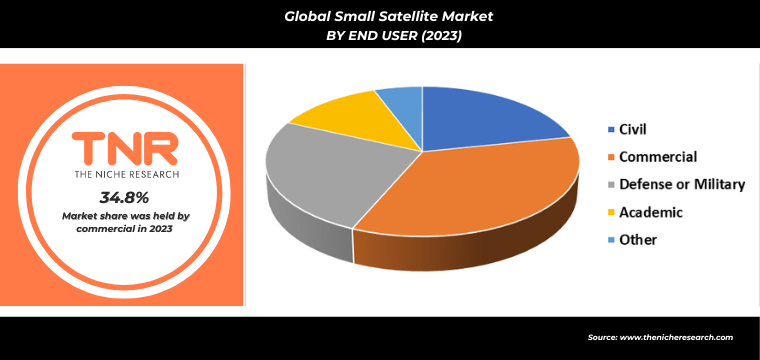
Small Satellite Market By Region
Europe is projected to be the fastest-growing region in the small satellite market during the forecast period. This growth is driven by increasing investments in space exploration, technological advancements, and the rising number of small satellites launches by European companies and space agencies. The region’s strong focus on innovation, coupled with supportive government policies and collaborations across the space industry, is expected to fuel its rapid expansion. Europe’s strategic initiatives are positioning it as a key player in the global small satellite market.

Global Small Satellite Market Dynamics
Global Small Satellite Market Growth Driver:
The global small satellite market is driven by the increasing demand for satellite-based services, particularly for global internet connectivity and Earth observation. The rise of satellite constellations for real-time data and communication solutions is propelling market growth. Small satellites’ cost-effectiveness and flexibility further attract investment from commercial entities, leading to a surge in deployments across various sectors.
Global Small Satellite Market Restraint:
A significant restraint in the global small satellite market is the complex regulatory landscape. Obtaining licenses and adhering to international space laws can be time-consuming and costly, potentially delaying satellite launches. Additionally, coordination with multiple agencies and compliance with stringent regulations regarding frequency allocation and orbital debris management add further challenges, limiting the speed at which new satellites can be deployed.
Global Small Satellite Market Opportunity:
The global small satellite market presents significant opportunities through advancements in miniaturization and power system technologies. Innovations in these areas enable more powerful and efficient satellites, expanding their capabilities for diverse applications like remote sensing and telecommunications. Additionally, the growing interest in space exploration and satellite services from emerging economies offers new market opportunities, with increasing investments driving further industry expansion.
Global Small Satellite Market Threat:
The growing threat of space debris poses a significant risk to the global small satellite market. As the number of small satellites in low Earth orbit increases, the potential for collisions and the creation of debris fields escalates. This not only endangers existing satellites but also complicates future launches and operations, potentially leading to stricter regulations and higher costs for satellite operators.
Competitive Landscape
The global small satellite market is highly competitive, with key players including Airbus, Planet Labs, and Lockheed Martin Corporation leading the industry. Emerging startups and established aerospace companies are intensifying competition through innovations and strategic partnerships, driving rapid technological advancements and expanding their market presence in this dynamic sector.
Some of the players operating in the small satellite market are
- Airbus
- Ball Corporation
- Boeing
- ISIS- Innovative Solutions Inc. Space B.V.
- Israel Aerospace Industries Ltd.
- Lockheed Martin Corporation
- OHB SE
- Orbital ATK, Inc.
- Planet Labs Inc.
- QinetiQ
- Surrey Satellite Technology Ltd
- Other Industry Participants
Global Small Satellite Market Scope
| Report Specifications | Details |
| Market Revenue in 2023 | US$ 12.8 Bn |
| Market Size Forecast by 2034 | US$ 66.6 Bn |
| Growth Rate (CAGR) | 16.2% |
| Historic Data | 2016 – 2022 |
| Base Year for Estimation | 2023 |
| Forecast Period | 2024 – 2034 |
| Report Inclusions | Market Size & Estimates, Market Dynamics, Competitive Scenario, Trends, Growth Factors, Market Determinants, Key Investment Segmentation, Product/Service/Solutions Benchmarking |
| Segments Covered | By Component, By Satellite Type, By Orbit, By Application, By End User, By Region |
| Regions Covered | North America, Europe, Asia Pacific, Middle East & Africa, Latin America |
| Countries Covered | U.S., Canada, Mexico, Rest of North America, France, The UK, Spain, Germany, Italy, Nordic Countries (Denmark, Finland, Iceland, Sweden, Norway), Benelux Union (Belgium, The Netherlands, Luxembourg), Rest of Europe, China, Japan, India, New Zealand, Australia, South Korea, Southeast Asia (Indonesia, Thailand, Malaysia, Singapore, Rest of Southeast Asia), Rest of Asia Pacific, Saudi Arabia, UAE, Egypt, Kuwait, South Africa, Rest of Middle East & Africa, Brazil, Argentina, Rest of Latin America |
| Key Players | Airbus, Ball Corporation, Boeing, SIS- Innovative Solutions Inc. Space B.V., Israel Aerospace Industries Ltd., Lockheed Martin Corporation, OHB SE, Orbital ATK, Inc., Planet Labs Inc., QinetiQ, Surrey Satellite Technology Ltd |
| Customization Scope | Customization allows for the inclusion/modification of content pertaining to geographical regions, countries, and specific market segments. |
| Pricing & Procurement Options | Explore purchase options tailored to your specific research requirements |
| Contact Details | Consult With Our Expert
Japan (Toll-Free): +81 663-386-8111 South Korea (Toll-Free): +82-808- 703-126 Saudi Arabia (Toll-Free): +966 800-850-1643 United Kingdom: +44 753-710-5080 United States: +1 302-232-5106 E-mail: askanexpert@thenicheresearch.com
|
Global Small Satellite Market
By Component
- Power System
- Propulsion System
- Payloads
- Solar Panel & Antenna Systems
- Others
By Satellite Type
- Micro-satellite
- Mini-satellite
- Nano-satellite
- Pico-satellite
- Femtosatellite
By Orbit
- Low Earth Orbit (LEO)
- Geostationary Equatorial Orbit (GEO)
- Middle Earth Orbit (MEO)
By Application
- Navigation & Mapping
- Earth Observation & Remote Sensing
- Science & Exploration
- Technology Development
- Satellite Communication
- Other
By End User
- Civil
- Commercial
- Defense or Military
- Academic
- Other
By Region
- North America (U.S., Canada, Mexico, Rest of North America)
- Europe (France, The UK, Spain, Germany, Italy, Nordic Countries (Denmark, Finland, Iceland, Sweden, Norway), Benelux Union (Belgium, The Netherlands, Luxembourg), Rest of Europe)
- Asia Pacific (China, Japan, India, New Zealand, Australia, South Korea, Southeast Asia (Indonesia, Thailand, Malaysia, Singapore, Rest of Southeast Asia), Rest of Asia Pacific)
- Middle East & Africa (Saudi Arabia, UAE, Egypt, Kuwait, South Africa, Rest of Middle East & Africa)
- Latin America (Brazil, Argentina, Rest of Latin America)
Report Layout:
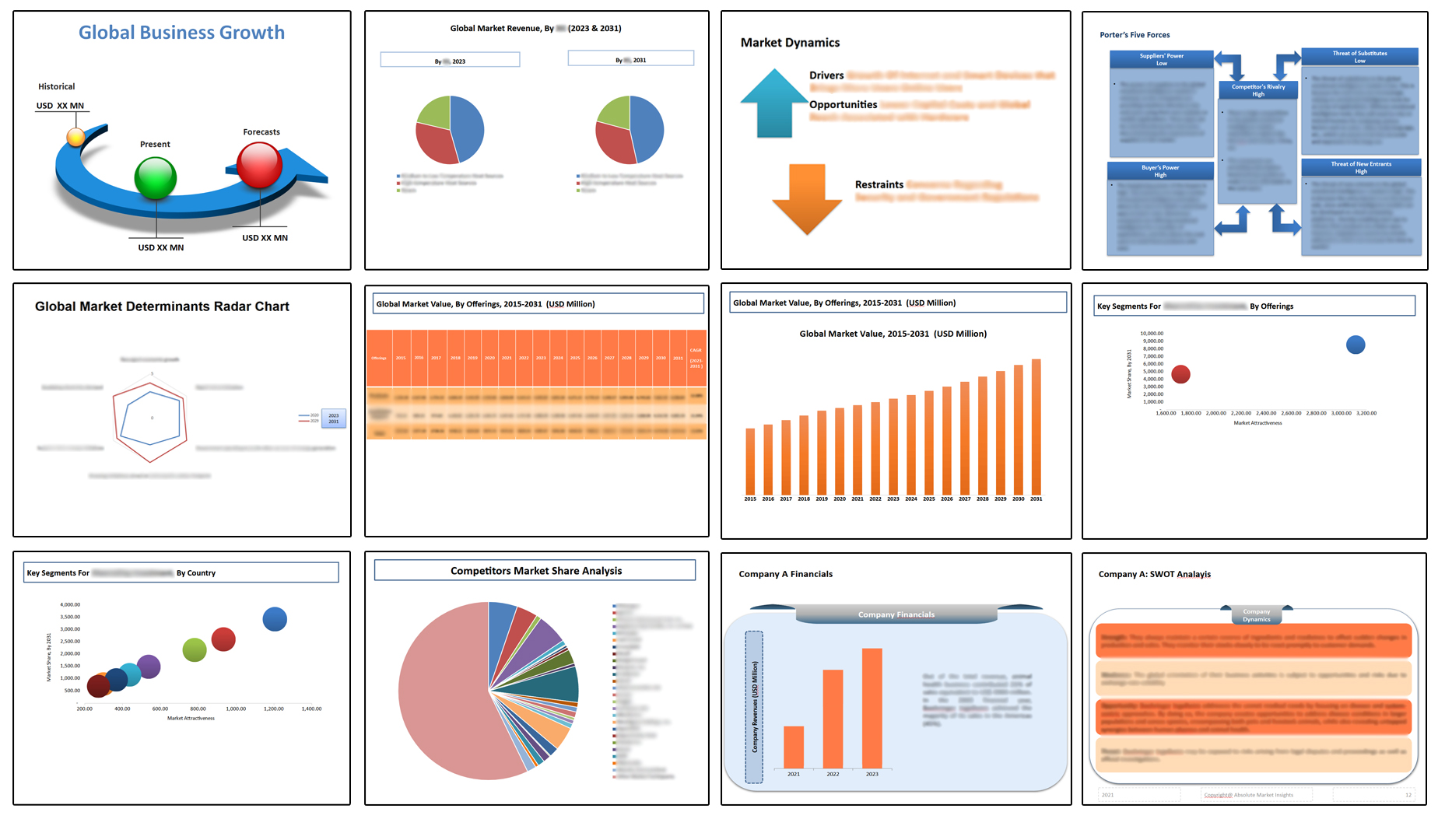
Table of Contents
Note: This ToC is tentative and can be changed according to the research study conducted during the course of report completion.
**Exclusive for Multi-User and Enterprise User.
Global Small Satellite Market
By Component
- Power System
- Propulsion System
- Payloads
- Solar Panel & Antenna Systems
- Others
By Satellite Type
- Micro-satellite
- Mini-satellite
- Nano-satellite
- Pico-satellite
- Femtosatellite
By Orbit
- Low Earth Orbit (LEO)
- Geostationary Equatorial Orbit (GEO)
- Middle Earth Orbit (MEO)
By Application
- Navigation & Mapping
- Earth Observation & Remote Sensing
- Science & Exploration
- Technology Development
- Satellite Communication
- Other
By End User
- Civil
- Commercial
- Defense or Military
- Academic
- Other
By Region
- North America (U.S., Canada, Mexico, Rest of North America)
- Europe (France, The UK, Spain, Germany, Italy, Nordic Countries (Denmark, Finland, Iceland, Sweden, Norway), Benelux Union (Belgium, The Netherlands, Luxembourg), Rest of Europe)
- Asia Pacific (China, Japan, India, New Zealand, Australia, South Korea, Southeast Asia (Indonesia, Thailand, Malaysia, Singapore, Rest of Southeast Asia), Rest of Asia Pacific)
- Middle East & Africa (Saudi Arabia, UAE, Egypt, Kuwait, South Africa, Rest of Middle East & Africa)
- Latin America (Brazil, Argentina, Rest of Latin America)
The Niche Research approach encompasses both primary and secondary research methods to provide comprehensive insights. While primary research is the cornerstone of our studies, we also incorporate secondary research sources such as company annual reports, premium industry databases, press releases, industry journals, and white papers.
Within our primary research, we actively engage with various industry stakeholders, conducting paid interviews and surveys. Our meticulous analysis extends to every market participant in major countries, allowing us to thoroughly examine their portfolios, calculate market shares, and segment revenues.
Our data collection primarily focuses on individual countries within our research scope, enabling us to estimate regional market sizes. Typically, we employ a bottom-up approach, meticulously tracking trends in different countries. We analyze growth drivers, constraints, technological innovations, and opportunities for each country, ultimately arriving at regional figures.Our process begins by examining the growth prospects of each country. Building upon these insights, we project growth and trends for the entire region. Finally, we utilize our proprietary model to refine estimations and forecasts.
Our data validation standards are integral to ensuring the reliability and accuracy of our research findings. Here’s a breakdown of our data validation processes and the stakeholders we engage with during our primary research:
- Supply Side Analysis: We initiate a supply side analysis by directly contacting market participants, through telephonic interviews and questionnaires containing both open-ended and close-ended questions. We gather information on their portfolios, segment revenues, developments, and growth strategies.
- Demand Side Analysis: To gain insights into adoption trends and consumer preferences, we reach out to target customers and users (non-vendors). This information forms a vital part of the qualitative analysis section of our reports, covering market dynamics, adoption trends, consumer behavior, spending patterns, and other related aspects.
- Consultant Insights: We tap into the expertise of our partner consultants from around the world to obtain their unique viewpoints and perspectives. Their insights contribute to a well-rounded understanding of the markets under investigation.
- In-House Validation: To ensure data accuracy and reliability, we conduct cross-validation of data points and information through our in-house team of consultants and utilize advanced data modeling tools for thorough verification.
The forecasts we provide are based on a comprehensive assessment of various factors, including:
- Market Trends and Past Performance (Last Five Years): We accurately analyze market trends and performance data from preceding five years to identify historical patterns and understand the market’s evolution.
- Historical Performance and Growth of Market Participants: We assess the historical performance and growth trajectories of key market participants. This analysis provides insights into the competitive landscape and individual company strategies.
- Market Determinants Impact Analysis (Next Eight Years): We conduct a rigorous analysis of the factors that are projected to influence the market over the next eight years. This includes assessing both internal and external determinants that can shape market dynamics.
- Drivers and Challenges for the Forecast Period:Identify the factors expected to drive market growth during the forecast period, as well as the challenges that the industry may face. This analysis aids in deriving an accurate growth rate projection.
- New Acquisitions, Collaborations, or Partnerships: We keep a close watch on any new acquisitions, collaborations, or partnerships within the industry. These developments can have a significant impact on market dynamics and competitiveness.
- Macro and Micro Factors Analysis:A thorough examination of both macro-level factors (e.g., economic trends, regulatory changes) and micro-level factors (e.g., technological advancements, consumer preferences) that may influence the market during the forecast period.
- End-User Sentiment Analysis: To understand the market from the end-user perspective, we conduct sentiment analysis. This involves assessing the sentiment, preferences, and feedback of the end-users, which can provide valuable insights into market trends.
- Perspective of Primary Participants: Insights gathered directly from primary research participants play a crucial role in shaping our forecasts. Their perspectives and experiences provide valuable qualitative data.
- Year-on-Year Growth Trend: We utilize a year-on-year growth trend based on historical market growth and expected future trends. This helps in formulating our growth projections, aligning them with the market’s historical performance.
Research process adopted by TNR involves multiple stages, including data collection, validation, quality checks, and presentation. It’s crucial that the data and information we provide add value to your existing market understanding and expertise. We have also established partnerships with business consulting, research, and survey organizations across regions and globally to collaborate on regional analysis and data validation, ensuring the highest level of accuracy and reliability in our reports.








